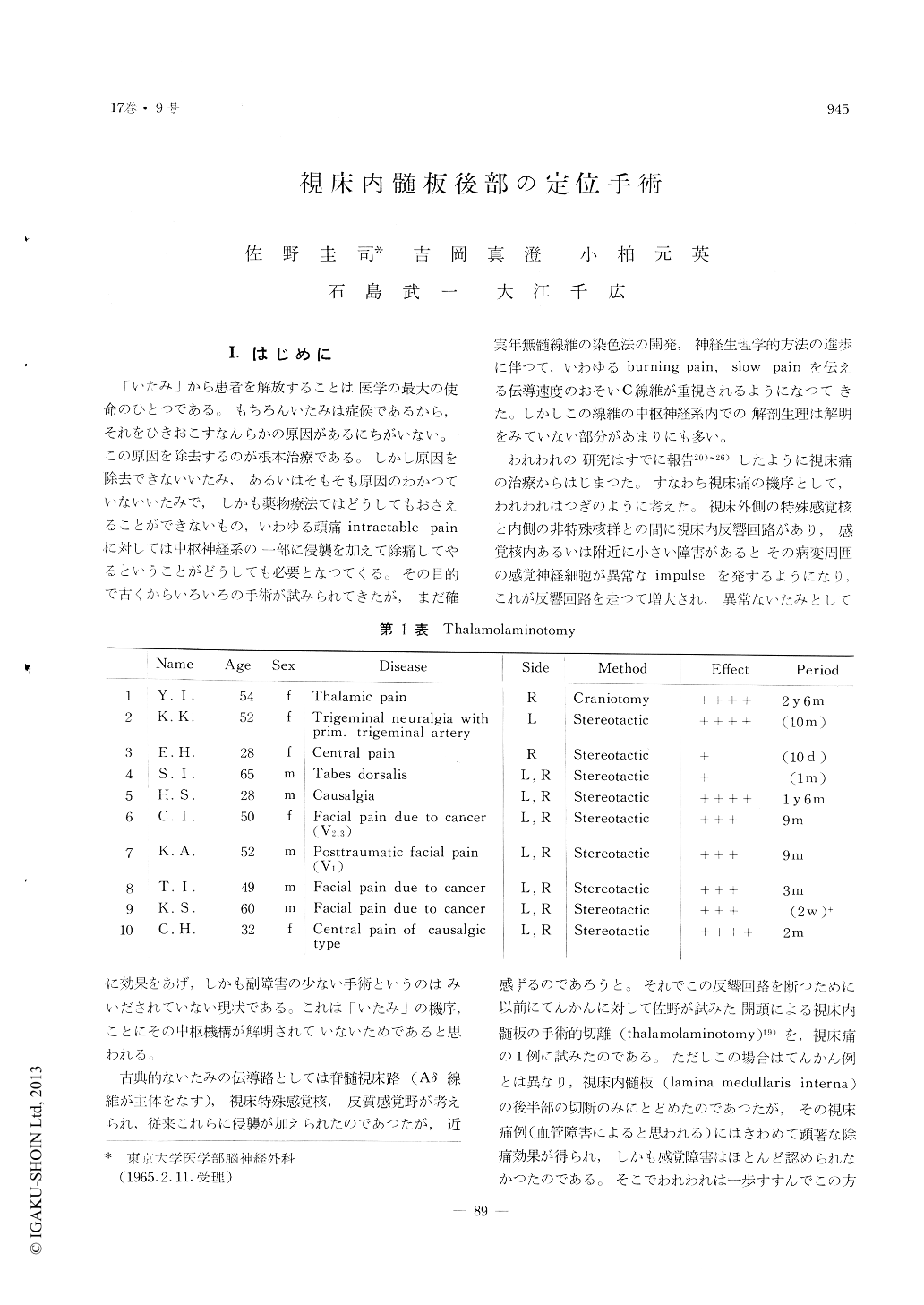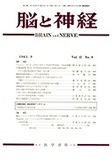Japanese
English
- 有料閲覧
- Abstract 文献概要
- 1ページ目 Look Inside
I.はじめに
「いたみ」から患者を解放することは医学の最大の使命のひとつである。もちろんいたみは症候であるから,それをひきおこすなんらかの原因があるにちがいない。この原因を除去するのが根本治療である。しかし原因を除去できないいたみ,あるいはそもそも原因のわかつていないいたみで,しかも薬物療法ではどうしてもおさえることができないもの,いわゆる頑痛intractable painに対しては中枢神経系の一部に侵襲を加えて除痛してやるということがどうしても必要となつてくる。その目的で古くからいろいろの手術が試みられてきたが,まだ確に効果をあげ,しかも副障害の少ない手術というのはみいだされていない現状である。これは「いたみ」の機序,ことにその中枢機構が解明されていないためであると思われる。
古典的ないたみの伝導路としては脊髄視床路(Aδ線維が主体をなす),視床特殊感覚核,皮質感覚野が考えられ,従来これらに侵襲が加えられたのであつたが,近実年無髄線維の染色法の開発,神経生理学的方法の進歩に伴つて,いわゆるburning Pain, slow painを伝える伝導速度のおそいC線維が重視されるようになつてきた。しかしこの線維の中枢神経系内での解剖生理は解明をみていない部分があまりにも多い。
This procedure, thalamolaminotomy, consists of destruction of the posterior half of the internal medullary lamina in the thalamus by means of ster-eotactically inserted special needles using electrocau-tery and mechanical manipulation.
In the pneumoencephalogram, a line connecting the point A, of 2mm above the mid-point of the inter-commissural line and 3mm lateral to the lateral wall of the third ventricle and the point B, 2mm above the posterior commissure and 7mm lateral to the lateral wall of the third ventricle is drawn. This line intersects the occipital skull about 30 mm lateral to the mid-line. A burr hole is made at the intersection point and a special needle is inserted along this line as far as the point A. This needle, 1. Omm in outer diameter, has a side hole 15 mm apart from its tip and is insulated except for the portion between this hole and the tip. When the long stylet which is fixed at the tip, is pushed, its distal portion peeps out from the side hole, forming a loop, the maximal height of which is about 10mm. The angle between the plane of this loop and the horizontal plane should be 70 degrees. By pushing out the loop up and down (but without rotating it) and by drawing the needle posteriorly, the internal medullary lamina will be mechanically cut. In addition, during the procedure, radiofrequency current (1 megacycle, 250-400mA, 20-25V) or D.C. current, 15V, 3-7mA, is applied to the needle, the loop and the tip of needle being the cathode and the ipsilateral shoulder being the reference. Thus a zonal lesion, about 2mm in brea-th, is made in the posterior half of the internal medullary lamina, the anterior border being the level of the mid-point of the intercommissural line, the inferior one being the intercommissural line, the su-perior one being about 12mm above this line and the posterior one being the level of the posterior comm-issure.
Ten cases of intractable pain, either thalamic, tabetic, causalgic or neoplastic in origin underwent the thalamolaminotomy, resulting in remarkable all-eviation of pain with practically no or only little sensory disturbances. Except in three cases, the procedure was done bilaterally, first on the side co-ntralateral to the pain, then on the ipsilateral side with an interval of 7 to 10 days. Lasting effects were obtained in 8 cases, the follow-up being from one month to two and a half years. There were no untoward psychic symptoms except for temporary stupor.
Prior to performing the thalamolaminotomy, elec-trical stimulation of the internal medullary lamina and the adjacent structures was done by means of stereotactically inserted concentric bipolar needle electrodes, 0.8mm in outer diameter, with the inte-rpolar distance of 0. 5mm. Figure 2 diagrammatically shows the results of stimulation in cases with local anesthesia. Electrical stimulation of a point at the black circles caused a marked increase of spontaneou s pain of which patients were complaining, irrespe-ctive of the side of stimulation, and at the same time, it elicited diffuse burning pain on the side co-ntralateral to the side of stimulation. A large circle indicates low threshold (e. g. those pains were ind-uced by stimulation, 5V, 3-6 c/sec, lmsec), and a small circle high threshold (e. g. they were elicited by stimulation, 15-25V, 100c/sec, lmsec). Stimul-ation of a point at the white circles caused an unp-leasant sensation which could hardly be localized anywhere in the body, the size of a circle being proportional to the irritability. As seen in Figure 2, the black circles are mostly distributed in the inferior and medial portion of the posterior half of the inter-nal medullary lamina and are not localized in a cer-tain nucleus such as the centre median or the pa-rafascicular nuleus. Low frequency stimulation (5V, 3-6c/sec) of a point at the black circles produced evoked potentials diffusely in all scalp leads, whereas stimulation of the poster-lateral ventral nucleus elicited augmenting responses predominantly in the ipsilateral postcentral region.
Neuroanatomical and neurophysiological experiments by various authors and by the present authors ind-icate that C-fibers and slow A-delta fibers are densly distributed in the posterior half of the internal me-dullary lamina and the adjacent structures, and that there are reverberating circuits between specific se-nsory and non-specific thalamic nuclei through the lamina.
Therefore the effects of the thalamolaminotomy may be explained by destruction of the C-fiber system and by disconnection of the intrathaea mic reverber-ating circuits.

Copyright © 1965, Igaku-Shoin Ltd. All rights reserved.


